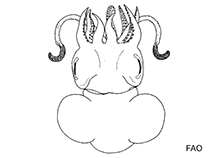Heteroteuthis dagamensis Robson, 1924
Upload your photos
Google image | No image available for this species;
drawing shows typical species in Sepiolidae.
Google image | No image available for this species;
drawing shows typical species in Sepiolidae.
Classification / Names Common names | Synonyms | CoL | ITIS | WoRMS
Cephalopoda | Sepiida | Sepiolidae | Heteroteuthinae
Environment: milieu / climate zone / depth range / distribution range Ecología
Demersal. Subtropical; 27°S - 35°S, 16°E - 34°E
Distribución Países | Áreas FAO | Ecosistemas | Ocurrencias, apariciones | Introducciones
Eastern Atlantic and Western Indian Ocean: Cape Verde and South Africa.
Length at first maturity / Tamaño / Peso / Age
Maturity: Lm ? range ? - ? cm
Life cycle and mating behavior Madurez | Reproducción | Puesta | Huevos | Fecundidad | Larva
Members of the class Cephalopoda are gonochoric. Male and female adults usually die shortly after spawning and brooding, respectively. Mating behavior: Males perform various displays to attract potential females for copulation. During copulation, male grasp the female and inserts the hectocotylus into the female's mantle cavity where fertilization usually occurs. Life cycle: Embryos hatch into planktonic stage and live for some time before they grow larger and take up a benthic existence as adults.
Main reference
Referencias | Coordinador | Colaboradores
Jereb, P. and C.F.E. Roper (eds.). 2005. (Ref. 1695)
IUCN Red List Status (Ref. 130435: Version 2024-1)
Data deficient (DD) ; Date assessed: 28 March 2009
CITES status (Ref. 108899)
Not Evaluated
CMS (Ref. 116361)
Not Evaluated
Threat to humans
Human uses
| FishSource |
Herramientas
Más información
Trophic Ecology
componentes alimenticios
Dieta
consumo de alimento
Ración
Despredadores
Dieta
consumo de alimento
Ración
Despredadores
Ecology
Population dynamics
Crecimiento
Age/Size
Length-weight
Length-length
Length-frequencies
Mass conversion
Reclutamiento
Abundancia
Age/Size
Length-weight
Length-length
Length-frequencies
Mass conversion
Reclutamiento
Abundancia
Life cycle
Distribution
Human Related
Perfil de acuicultura
Stamps, Coins Misc.
Stamps, Coins Misc.
Outreach
References
Fuentes de Internet
BHL | BOLD Systems | CISTI | DiscoverLife | FAO(Publication : search) | Fishipedia | GenBank (genome, nucleotide) | GloBI | Gomexsi | Google Books | Google Scholar | Google | PubMed | Árbol de la vida | Wikipedia (Go, búsqueda) | Expediente Zoológico
Estimates based on models
Price category
(Ref. 80766):
Unknown.



